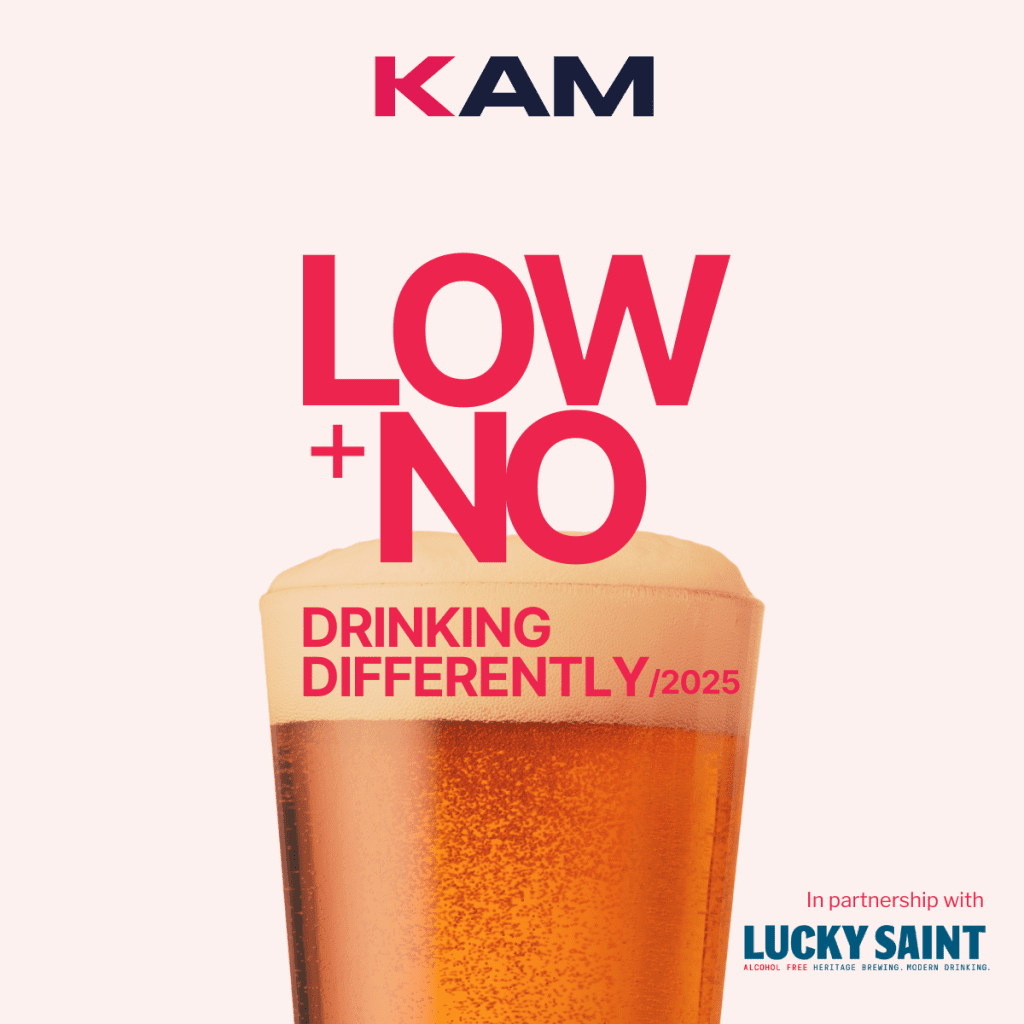KAM Insight’s latest report, produced in partnership with alcohol-free beer brand Lucky Saint, dives deep into the new reality of how Brits are drinking in 2025. Based on nationally representative research, Drinking Differently explores the rise of a more flexible, intentional and health-conscious approach to alcohol—and the massive opportunity this presents for pubs, bars and restaurants.
A new flexible, dynamic approach
The new report reveals that a growing number of consumers are navigating nights out with a more dynamic, fluid approach to alcohol—swapping, mixing and pacing their choices depending on the occasion.
According to Drinking Differently: Low & No 2025, nearly 36 million UK adults are actively moderating their alcohol intake (76% of those who drink alcohol) but not in a rigid or restrictive way. Instead, Brits are weaving together full-strength, mid-strength and alcohol-free options to suit the moment. Less than 2-in-3 drinks consumed in hospitality venues are now full-strength.
Forget all-or-nothing approaches to alcohol. The UK’s drinking habits are undergoing a transformation, not defined by strict abstinence or even a linear reduction, but by flexibility. Moderation today doesn’t mean giving up alcohol. It means drinking more intentionally, more flexibly. This new blended approach to booze is changing how people drink and more importantly, how they want to be served.

From zebra striping to coasting
Last year’s report identified a growing consumer trend towards “zebra striping” – alternating between alcoholic and alcohol-free drinks within a single occasion – this has increased with 34% of UK adults now saying they do this regularly (up from 28% last year.) This year’s research highlights different moderation tactics which are being embraced including 1-in-5 who actively opt for mid-strength options throughout an occasion referred to as ‘coasting’.
Nearly 40% of all drinks that Brits now consume in pubs, bars and restaurants aren’t full strength, a clear sign that the standard “pint or nothing” mentality is being replaced by a more diverse, nuanced approach to social drinking“
Katy Moses, MD, KAM
The rapid evolution of the low & no category has been instrumental in enabling this flexible drinking culture. Once seen as a compromise, alcohol-free options are now mainstream, well-crafted, and expected – especially in hospitality settings.
Low and no helps fuel new drinking tactics
The research showed that 31% of Brits will now choose a low or no-alcohol beer when visit a hospitality venue and not drinking alcohol. This is, up from just 9% five years ago meaning that low & no beer has jumped from 7th to 2nd most popular drink choice when not drinking alcohol in a pub, bar or restaurant.
“As a society, the choices around what we consume are changing. People are making deliberate decisions about how they use their time, how they take care of their physical and mental wellbeing, what they choose to eat and drink. Historically, alcohol-free consumption has been about specific times of the year, or for certain occasions. Now everyone is drinking it, right throughout the year and through the week. It’s changing throughout an throughout an individual day too – you can now buy an alcohol-free beer with your lunchtime meal deal in supermarkets.”
Luke Boase, Founder, Lucky Saint
But with demand for low and no rising fast, the pressure is now on hospitality operators to keep up. The research shows there is a widening gap between expectations and reality with 37% of UK adults saying they’ve left a venue early or felt disappointed due to poor low & no options – a 6pt increase on last year. 24% of customers still default to tap water when not drinking – this is down slightly from 28% in 2020 but still equates to an estimated £800 million missed opportunity for the on-trade.
This shift toward flexible drinking isn’t a threat, it’s an open door. This isn’t about being anti-alcohol. It’s about helping customers drink the way they want to, which increasingly means a mix of full-strength, mid-strength and alcohol-free options throughout the week, and even within the same visit. The venues that embrace this more fluid approach to alcohol can boost dwell time, improve customer satisfaction, and open themselves up to a wider audience.
You can purchase the full Low+No: Drinking Differently report here or if you’re interested in accessing more of our hospitality research in general then take a look at our Knowledge Hub (lots of free insight!)
